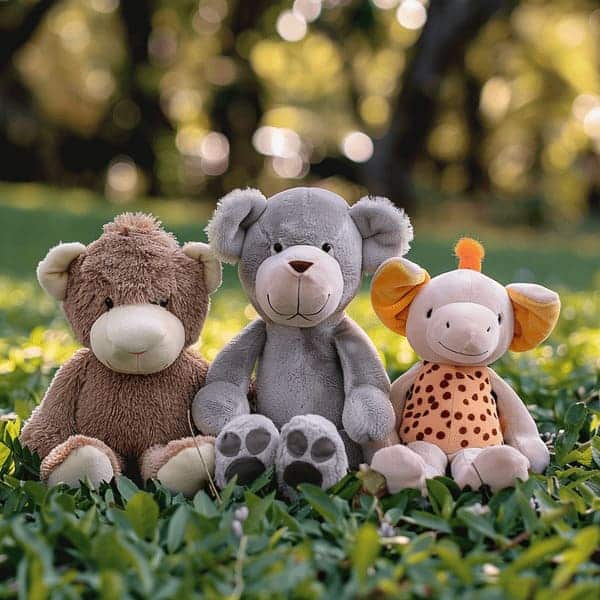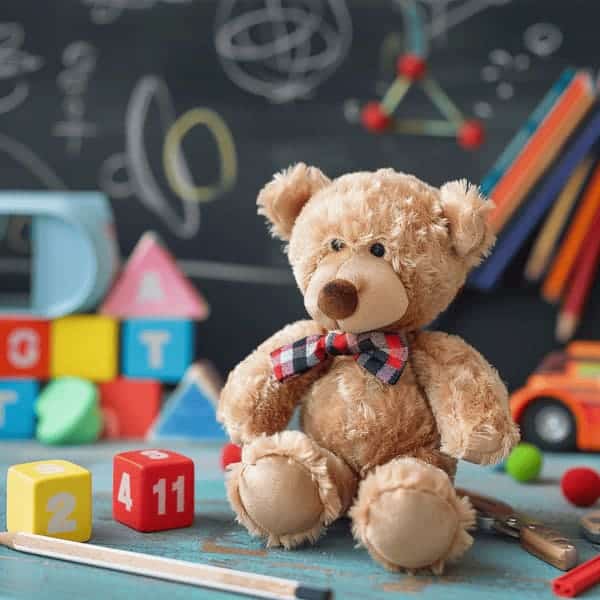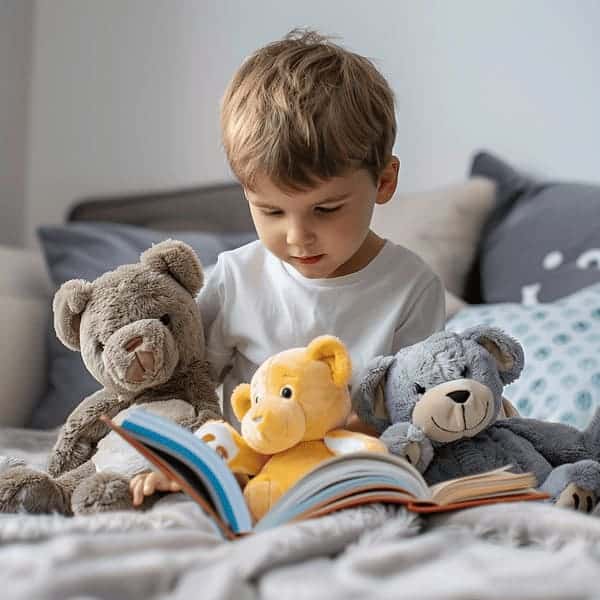Discover the surprising depth of benefits plush toys offer, beyond their undeniable cuteness. From fostering emotional connections to enhancing developmental skills, plush toys are not just children’s playthings but powerful tools in cognitive and emotional development. Join us as we explore how these soft companions do more than just entertain, providing lasting value in various unexpected ways
As a general rule, plush toys offer significant emotional and developmental benefits. Here are nine key advantages they provide:
- Emotional Comfort: Provides security and comfort.
- Sensory Development: Enhances tactile and sensory processing.
- Language Skills: Encourages communication and vocabulary growth.
- Social Skills: Fosters empathy and cooperative play.
- Sleep Aid: Offers comfort and security at bedtime.
- Cognitive Skills: Stimulates creativity and problem-solving.
- Memory Formation: Helps preserve cherished memories.
- Emotional Expression: Facilitates emotional expression and processing.
- Stress Reduction: Aids in relaxation and stress relief.

Dive Deeper into the World of Plush Toys
Curious to learn more about how plush toys can play a pivotal role in development and well-being? Continue reading as we delve into detailed explanations of each benefit listed above. We will explore the scientific backing and real-world applications that make plush toys invaluable tools in both educational settings and home environments. Discover the profound impact these soft companions can have on emotional and cognitive growth through engaging stories and expert insights.
Exploring the Multifaceted Benefits of Plush Toys
Plush toys, often seen as mere children’s playthings, hold a surprising depth of benefits that extend far beyond their soft exteriors. These benefits impact various aspects of development and emotional well-being, making plush toys valuable tools in both educational and therapeutic contexts.
Emotional and Psychological Comfort
Plush toys serve as a source of comfort for individuals of all ages. In therapeutic settings, psychologists use plush toys to help children express emotions that they might otherwise find difficult to articulate. For adults, these toys can evoke a sense of nostalgia and provide comfort in times of stress. Studies have shown that holding a plush toy can significantly reduce anxiety levels in patients undergoing medical treatments.
Sensory Development and Learning
For infants and toddlers, plush toys are excellent tools for sensory development. The varied textures and materials of plush toys stimulate tactile responses, which are crucial for brain development. Early interaction with these textures helps children develop motor skills and an understanding of their environment.

Enhancing Language Skills
Language development is another significant benefit of plush toys. As children engage in dialogues with their plush toys, they practice language skills in a safe and non-judgmental environment. This imaginative play enhances vocabulary and communication skills, as observed in numerous childcare studies.
Social and Emotional Skills
Role-playing with plush toys prepares children for real-world interactions. By caring for their plush toys, children learn empathy, sharing, and how to interpret social cues. These toys often become part of a child’s first friendships, offering lessons in companionship and understanding.

Sleep and Security
Many children find it easier to sleep with a plush toy by their side, which can act as a transitional object and offer a sense of security at bedtime. This attachment can help them develop independence in their sleeping habits.
Cognitive Development
Engaging with plush toys encourages creativity and imagination. Children often invent scenarios and roles for their toys, which enhances cognitive flexibility and problem-solving skills.
Here’s a visual breakdown of these benefits in a table format:
| Benefit | Description |
|---|---|
| Emotional Comfort | Reduces anxiety and provides comfort during stressful or unfamiliar situations. |
| Sensory Development | Stimulates tactile, visual, and auditory senses. |
| Language Skills | Encourages communication through role-play and storytelling. |
| Social Skills | Teaches empathy, sharing, and interpreting social cues through care and interaction. |
| Sleep Aid | Acts as a transitional object for better independence and comfort at night. |
| Cognitive Development | Enhances creativity, imagination, and problem-solving skills. |
What Are Plush Toys Used For?
Plush toys serve multiple functions across various settings. As a whole, they are not only cherished playthings but also vital tools in education and therapy. They provide emotional support, facilitate learning through interactive play, and assist in therapy by acting as transitional objects that help children express complex emotions. In essence, plush toys enhance emotional, cognitive, and social development.
Beyond their primary role as comforting companions, plush toys extend their reach into developmental and therapeutic realms. Their versatility makes them invaluable in nurturing environments:
- Educational Enhancement: Plush toys are integral in preschool and early education classrooms. They are often employed in teaching color recognition, alphabets, and simple math. Educators utilize plush toys to make abstract concepts tangible, making learning engaging and accessible for young children.
- Therapeutic Integration: In therapy sessions, plush toys provide a medium through which children can project their feelings, making it easier for therapists to access and address hidden emotions. They are particularly effective in sessions involving non-verbal communication or when dealing with trauma.
- Social Interaction: For children, plush toys often act as their first friends with whom they practice and develop their social skills. These toys play a critical role in role-playing exercises that teach children about empathy, sharing, and conflict resolution.
- Comfort in Transition: Especially in hospitals or during significant life changes, plush toys provide comfort to children and adults alike, offering a semblance of stability and security in unfamiliar or uncomfortable settings.

How Do Plushies Help Child Development?
Plush toys significantly contribute to various aspects of child development. As a general rule, they support emotional well-being, enhance cognitive abilities, and foster social skills. Through imaginative play and interactive engagement, plush toys provide a safe and nurturing environment for children to grow and learn.
Plush toys play a crucial role in the developmental stages of a child’s life. Here’s how they specifically aid in child development without repeating earlier points:
- Imagination and Creativity: Plush toys encourage children to use their imagination. By inventing stories and scenarios, children develop creative thinking. This imaginative play helps them understand different perspectives and enhances their ability to think outside the box.
- Problem-Solving Skills: During play, children often encounter situations that require problem-solving. Whether it’s figuring out how to dress their toy or setting up a play scene, these activities help develop critical thinking and decision-making skills.
- Motor Skills Development: Handling and manipulating plush toys can aid in the development of fine motor skills. Actions like dressing, carrying, and positioning the toys require coordination and dexterity, which are essential for overall physical development.
- Role-Playing Different Roles: Plush toys allow children to experiment with different roles and scenarios, helping them understand various social roles and expectations. This role-playing can be instrumental in helping children navigate social norms and behaviors.
- Security and Confidence: Having a plush toy can provide children with a sense of security. This security can boost their confidence, making them more willing to explore new environments and experiences. It provides a stable emotional base from which they can develop independence.

The Role of Plush Toys in Therapy
Plush toys are not just for play; they hold significant therapeutic value across various age groups and settings. Their comforting presence and non-threatening nature make them ideal tools in therapeutic environments.
Therapeutic Communication: In therapy sessions, particularly with children, plush toys can act as intermediaries. Therapists use these toys to create a safe space where children feel more comfortable expressing their thoughts and emotions. For instance, a child might find it easier to talk about their feelings through a plush toy, which can serve as a stand-in for the child’s own voice.
Trauma Recovery: For individuals recovering from trauma, plush toys can provide a sense of stability and security. They can serve as grounding tools during therapy, helping patients stay connected to the present moment and reduce feelings of anxiety or fear.

Emotional Regulation: Plush toys are used to teach and practice emotional regulation. Through role-playing and interaction with these toys, children learn to identify and manage their emotions. This process is essential for developing healthy coping mechanisms.
Building Trust: In therapeutic settings, establishing trust between the therapist and the patient is crucial. Plush toys can bridge this gap, particularly with younger patients. They provide a familiar and comforting presence, which can make the therapeutic process less intimidating.
Behavioral Therapy: Plush toys are often used in behavioral therapy to model positive behaviors and reinforce learning. Therapists might use plush toys to demonstrate social skills, appropriate behavior, or to practice new strategies in a controlled, safe environment.
The Educational Benefits of Plush Toys
Plush toys are powerful educational tools that extend learning beyond traditional methods. They offer interactive and engaging ways for children to acquire new skills and knowledge, making learning a more enjoyable and effective process.
Early Learning and Literacy: Plush toys are often used to introduce young children to basic concepts such as numbers, letters, and colors. Teachers and parents can create playful learning scenarios where children learn these fundamentals through songs, stories, and games involving plush toys.
Language Development: Engaging in conversations with plush toys can significantly enhance a child’s language skills. By narrating stories, asking questions, and role-playing with their toys, children practice speaking, listening, and comprehension skills, which are crucial for language development.
Mathematical Concepts: Plush toys can be incorporated into activities that teach counting, sorting, and basic arithmetic. For example, children can count how many plush toys they have, sort them by size or color, or even use them to perform simple addition and subtraction exercises.

Science and Nature: Plush toys designed for animals or plants can be used to teach children about biology and the natural world. Educators can create interactive lessons where children learn about different species, habitats, and ecosystems using their plush toys as visual aids.
Problem-Solving Skills: Playing with plush toys often involves creating scenarios and solving problems that arise during play. This process enhances children’s critical thinking and problem-solving abilities. For instance, children might figure out how to build a ‘house’ for their plush toys or solve conflicts that arise in their imaginative play.
Social Studies and Cultural Awareness: Plush toys representing various cultures and historical figures can be used to teach children about diversity, history, and social studies. These toys help children understand and appreciate different cultures and historical events through engaging, hands-on learning experiences.

